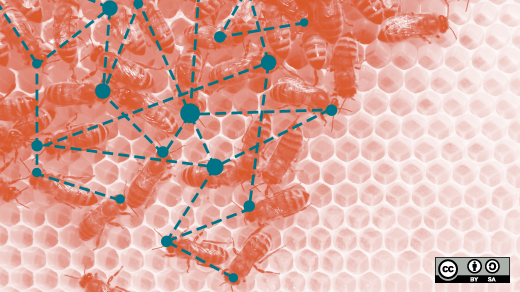The sharing economy is a new industry built around sharing resources instead of buying things new from a factory. If an asset is not being used to capacity by the owner, there may be others who can use it so the asset is utilized to its full potential. The Sharing Economy: The End of Employment and the Rise of Crowd-Based Capitalism, by Arun Sundararajan, gave me many new insights about this business model and how it relates to many open organization activities.
The business model of the sharing economy
The sharing economy is all about the transparency of people's unused or underused assets. Through various computer platforms, communities form among parties that provide and parties that use these excess assets. These communities can greatly expand inclusivity, for example by extending resources to poorer communities and bringing more people into the global economy. Anyone can become part of the larger economy by providing excess resources, including underused time, tools, and capacity. The sharing economy establishes new opportunities for both supply and demand opportunities. Through newly developed platforms, people can collaborate around goods and services in a way that has not been possible before.
Put simply, all five open organization principles are represented in this business model:
- Transparency
- Inclusivity
- Adaptability
- Collaboration
- Community
New social values as a sharing business model
According to Sundararajan, a professor at New York University's Stern School of business, social values in the sharing economy are, at best, weak in commercial economies.
For example, services like home cleaning, plumbing, painting, or electrical work can be offered or hired through a labor marketplace like Handy, TaskRabbit, or Thumbtack. Participants can validate their identities by sharing data from a valid Facebook or LinkedIn account. While all of these examples involve sharing—in this case, sharing time—none of these services are offered for free. You get paid by the person you serve, or you pay the provider who shares what they have with you. Providing services for profit is not the principal goal, however. While these activities can be profitable for both supplier and receiver, the opportunity to make new social connections can be fun and rewarding.
The sharing economy is not new, according to Sundararajan. Before the Industrial Revolution, much economic exchange was peer-to-peer, embedded in communities, and intertwined in various ways with social relations. About 50% of the population at the turn of the 20th century was self-employed. By 1960, that number was around 15%, as large corporations increasingly dominated the economy. Now, digital technologies are bringing sharing behavior, self-employment, and community-based exchange back to life.
Technology is building new forms of economic communities far beyond family, friends, neighborhoods, cities, or even nations. The sociologist Juliet Schor calls this "stranger sharing," including building trusting relationships with people you don't directly know. Sundararajan calls this "crowd-based capitalism," and it could radically transform the meaning of a job, reshaping employment regulations and social safety nets.
Exposing underused assets
There are a lot of slack resources in most economies. Many assets sit idle most of the time—for instance, the average car is driven just an hour a day. Workers in a company have time and skills that go unused. Sundararajan contends that if you connect people with unused assets (an item, space, time, or skills) to people willing to pay to use them, you reduce waste and end up with a more efficient system. Technology is already bringing those parties together and building supplier/user communities, as in food-sharing and car-sharing cooperatives, barter exchange systems, bike-sharing initiatives, cohousing programs, and coworking policies.
The Sharing Economy explains that the conditions for collaborative consumption occur when there is a critical mass of idle capacity. There are three key factors:
- Untapped value of unused or underused assets
- Belief in serving the common good with what is available
- A system that allows strangers to meet and trust each other
People's spare time, items, skills, and space are being detected, dramatized, and made more transparent through digital networks. For example, Alex Stephany is the CEO of JustPark, a peer-to-peer marketplace that matches people who have empty parking spaces with those looking for a place to park. In his book The Business of Sharing: Making It in the New Sharing Economy, he defines the sharing economy as "the value in taking underutilized assets and making them accessible online to a community, leading to a reduced need for ownership of those assets." Stephany has proposed five characteristics of a sharing economy:
- It creates economic value.
- Its raw materials are currently available underutilized assets.
- It operates through online accessibility.
- It builds a community that develops trusting relationships, social interaction, and value sharing.
- It reduces the need for sole ownership of an asset.
The technology for these characteristics is supported by free software (or app development), distributed computing, and population-scale digital networks. These huge networks must be developed to support trusted, highly distributed communities.
Purpose over profits
Much of the world is experiencing a new economic model that includes older economic models once marginalized under capitalism. The capital cost of effective economic action in the industrial economy shunted sharing to the periphery. With the technology mentioned above more available, the sharing economy will become more mainstream.
Furthermore, social characteristics, social cues, and differing motivations in the sharing economy are replacing profit-only goals. Characteristics such as generating information and motivating action will change how people think about basic economic activities. There will be a move toward purpose-driven communities within the profit-driven sectors of the sharing economy. Networking in this economy will be more peer-to-peer and have different production systems, governance systems, and ownership arrangements. Powered by TCP/IP protocol, a truly decentralized system will replace centralized distribution and govern supply chains and flows.
In his book Remix: Making Art and Commerce Thrive in the Hybrid Economy, Lawrence Lessig describes thin sharing economies as "economies where the motivation is primarily me-regarding or meant to serve the individual." By contrast, thick sharing economies are "economies where the motivations are at least ambiguous between me and thee motivation," or, in other words, motivation is oriented in some part toward the self and in some part toward others.
Commercial economies build value with money at their core. Sharing economies build value while ignoring money. Between these two economies, there is an increasingly important third economy that builds upon both the sharing and commercial economies and adds value to each. This hybrid economy may start with a commercial entity, for example, a business-model platform that leverages value from sharing. Or it could begin with a social connection platform that builds a commercial entity to support its sharing aims better.
Building a trusting community
In a sharing economy, trusting others will be transformed from a scarce resource to an abundant one through available communication technology. The sharing economy allows people to trust strangers at levels that were not previously possible through multiple systems generating reliable digital cues—a digital trust infrastructure. According to Sundararajan, the emergence of today's sharing economy is primarily due to digital enablers that have gradually gained strength and acceptance, mainly through mass-market smartphones, ubiquitous wireless broadband, along with an ever-improving trust system. This includes digitized real-world social networks built on decentralized marketplace protocols, identification systems, recommendation systems, testimonials, and peer-to-peer referrals.
To establish trust in an online setting, Sundarajan proposes three factors:
- Verify identity: Consider getting references and third-party confirmation.
- Confirm intentions: Does this person have other competing interests within this agreement? Determine what they hope to achieve for themselves, including the joy of helping others.
- Determine capacity: Can this person really do what they say they can? Analyze the person’s ability to deliver on their side of the arrangement.
In addition to the above, Sundararajan suggests asking these questions when assessing semi-anonymous, internet-based peer-to-peer settings:
- What is the status of prior interactions? Could you try a small, low-risk test and determine trustworthiness?
- What is the experience of others? How have others been treated?
- What are the platform brand and policy conditions? Through the platform, are there any validation procedures?
- What is the overall digitized reputation in the community? Take a look at any analytics available, including reviews and testimonials.
- Are external validations or references available? Are there any independent evaluations offered?
Familiarity is a cumulative process that develops over time. Each positive experience can increase trust, particularly when announced on a reputation system. For instance, eBay has created a Power Sellers classification to identify high-trust individuals. In this system, the platform does the vetting, so the provider can build trust just by being accepted. Other means of establishing identity and trustworthiness could include having a mobile number tied to a monthly subscription plan or holding a driver's license or credit card in front of a webcam for a service like Jumio to validate your identity.
Currently, a good reputation on one platform may not be transferred to another platform. The platform Traity is building a general-purpose reputation program. It also verifies your government ID and links to your digital social capital on Facebook or LinkedIn. This can help make people more comfortable with others they've never met. These identity measures will further enable the introduction and application of the open organization principle of community building.
In future articles on this topic, I will present many sharing platforms that are available today and discuss what Sundararajan believes the future holds for the sharing economy.







Comments are closed.